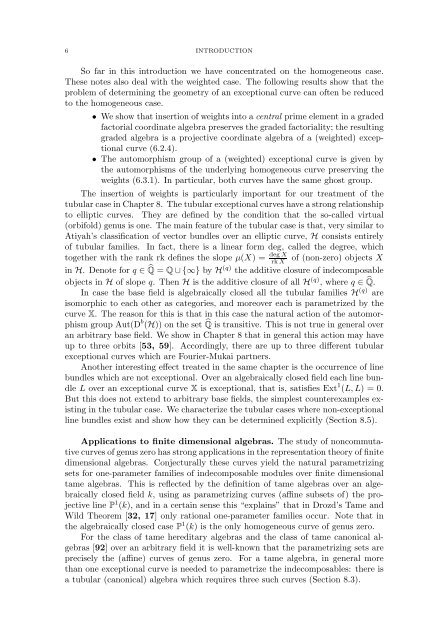MEMOIRS
MEMOIRS
MEMOIRS
- No tags were found...
Create successful ePaper yourself
Turn your PDF publications into a flip-book with our unique Google optimized e-Paper software.
6 INTRODUCTIONSo far in this introduction we have concentrated on the homogeneous case.These notes also deal with the weighted case. The following results show that theproblem of determining the geometry of an exceptional curve can often be reducedto the homogeneous case.• We show that insertion of weights into a central prime element in a gradedfactorial coordinate algebra preserves the graded factoriality; the resultinggraded algebra is a projective coordinate algebra of a (weighted) exceptionalcurve (6.2.4).• The automorphism group of a (weighted) exceptional curve is given bythe automorphisms of the underlying homogeneous curve preserving theweights (6.3.1). In particular, both curves have the same ghost group.The insertion of weights is particularly important for our treatment of thetubular case in Chapter 8. The tubular exceptional curves have a strong relationshipto elliptic curves. They are defined by the condition that the so-called virtual(orbifold) genus is one. The main feature of the tubular case is that, very similar toAtiyah’s classification of vector bundles over an elliptic curve, H consists entirelyof tubular families. In fact, there is a linear form deg, called the degree, whichtogether with the rank rk defines the slope µ(X) = deg Xrk Xof (non-zero) objects Xin H. Denote for q ∈ ̂Q = Q ∪{∞} by H (q) the additive closure of indecomposableobjects in H of slope q. ThenH is the additive closure of all H (q) ,whereq ∈ ̂Q.In case the base field is algebraically closed all the tubular families H (q) areisomorphic to each other as categories, and moreover each is parametrized by thecurve X. The reason for this is that in this case the natural action of the automorphismgroup Aut(D b (H)) on the set ̂Q is transitive. This is not true in general overan arbitrary base field. We show in Chapter 8 that in general this action may haveup to three orbits [53, 59]. Accordingly, there are up to three different tubularexceptional curves which are Fourier-Mukai partners.Another interesting effect treated in the same chapter is the occurrence of linebundles which are not exceptional. Over an algebraically closed field each line bundleL over an exceptional curve X is exceptional, that is, satisfies Ext 1 (L, L) =0.But this does not extend to arbitrary base fields, the simplest counterexamples existingin the tubular case. We characterize the tubular cases where non-exceptionalline bundles exist and show how they can be determined explicitly (Section 8.5).Applications to finite dimensional algebras. The study of noncommutativecurves of genus zero has strong applications in the representation theory of finitedimensional algebras. Conjecturally these curves yield the natural parametrizingsets for one-parameter families of indecomposable modules over finite dimensionaltame algebras. This is reflected by the definition of tame algebras over an algebraicallyclosed field k, using as parametrizing curves (affine subsets of) the projectiveline P 1 (k), and in a certain sense this “explains” that in Drozd’s Tame andWild Theorem [32, 17] only rational one-parameter families occur. Note that inthe algebraically closed case P 1 (k) is the only homogeneous curve of genus zero.For the class of tame hereditary algebras and the class of tame canonical algebras[92] over an arbitrary field it is well-known that the parametrizing sets areprecisely the (affine) curves of genus zero. For a tame algebra, in general morethan one exceptional curve is needed to parametrize the indecomposables: there isa tubular (canonical) algebra which requires three such curves (Section 8.3).
















